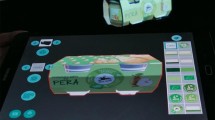Abstract
This paper presents a new perspective of the impact of collaboration technology on the degrees of engagement and specific interaction zones in interactive workspaces. The study is at the intersection of the design of physical work spaces, i.e., bricks, rich electronic content such as video, audio, sketching, CAD, i.e., bits, and new ways people behave in communicative events, i.e., interaction. The study presents: (1) an innovative multi-modal collaboration technology, called RECALL (patented by Stanford University), that supports the seamless, real-time capture of concept generation during project brainstorming and project review sessions, (2) the deployment of RECALL in an interactive workspace that supports real project review sessions, called FISHBOWL, and (3) the observations of the impact of RECALL and the interactive workspace on degrees of engagement and interaction zones as it is deployed in the specific FISHBOWL sessions.






Similar content being viewed by others
References
Cross N, Christiaans H, Dorst K (1996) Analysing design activity, 1st edn. Wiley, West Sussex, England
Cross N, Roozenburg N (1992) Modelling the design process in engineering and architecture. J Eng Des 3(4):325–337
Davenport T, Prusak L (1998) Working knowledge: how organizations manage what they know. Boston Harvard Business School Press, Boston, Massachusetts
Eastman CM (1969) Cognitive processes and ill-defined problems: a case study from design. In: Walker DE, Norton LM (eds) Proceedings of the international joint conference on artificial intelligence (IJCAI’69), Washington, DC, May 1969, pp 675–699
Fruchter R, Yen S (2000) RECALL in action. In: Fruchter R, Roddis K, Pena-Mora F (eds) Proceedings of the ASCE ICCCBE-VIII conference, Stanford, 14–16 August 2000
Fruchter R (1999) Architecture, engineering, construction teamwork: a collaborative design and learning space. J Comput Civil Eng 13(4):261–270
Fruchter R (2001) Bricks & bits & interaction. In: Terano T, Nishida T, Namatame A, Ohsawa Y, Tsumoto S, Washio T (eds) Special issue on exploring new frontiers on artificial intelligence, Lecture notes on artificial intelligence (LNAI) vol 2253. Springer, Berlin Heidelberg New York
Goel V (1995) Sketches of thought. MIT Press, Cambridge, Massachusetts
Goldschmidt G (1991) The dialectics of sketching. Creativity Res J 4(2):123–143
Kosslyn S (1981) The medium and the message in mental imagery: a theory. Psychol Rev 88:46–66
Lave J, Wenger E (1991) Situated learning: legitimate peripheral participation. Cambridge University Press, Cambridge, UK
Olszweski EJ (1981) The draughtsman’s eye: late renaissance schools and styles. Cleveland Museum of Art, Indiana University
Schön DA (1983) The reflective practitioner. Basic Books, New York
Stiedel RF, Henderson JM (1983) The graphic languages of engineering. Wiley, New York
Tversky B (1999) What does drawing reveal about thinking?. In: Gero JS, Tversky B (eds) Proceedings of the conference on visual and spatial reasoning in design, Sydney, Australia
Author information
Authors and Affiliations
Corresponding author
Rights and permissions
About this article
Cite this article
Fruchter, R. Degrees of engagement in interactive workspaces. AI & Soc 19, 8–21 (2005). https://doi.org/10.1007/s00146-004-0298-x
Received:
Accepted:
Published:
Issue Date:
DOI: https://doi.org/10.1007/s00146-004-0298-x




